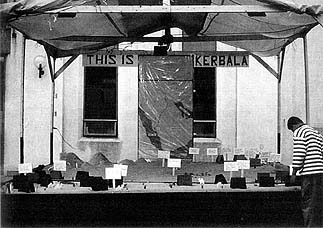| • | • | • |
“This is Karbala”
During the Ashura period, a scale model of Karbala was erected outside along the rear wall of the center building (fig. 35). I was told that this custom had recently become popular in Tanzania and had made its way to North America in the past few years. The model battlefield was laid out in a wooden box filled with sand. A trench was dug through the sand to represent the river Euphrates. The tents of the forces of Husain, as well as those of Caliph Yazid’s general, ‘Umar, were erected in the relevant locations and marked with signs. Toy soldiers and horses were placed in different positions on different days to represent the changing circumstances of the combatants. Signs identifying the location of important events of the battle such as “Martyrdom place of Imam Hussein, Son of Ali and Fatema, Grandson of the Holy Prophet,” “Place of Amputation of the Left Arm of Hazrat Abas Ibne Ali,” and “Place where Ali Ashgar was Buried” were placed on the model battlefield. A roof was erected over the entire area, and a sign was hung over the model battlefield that stated “This is Karbala.” A large map on the back wall of the model showed the route Husain and his followers took from Mecca to Karbala.

Figure 35. Model of Karbala outside the Ja‘ffari Center. Photograph by Vernon Schubel.
On the last three nights, a cassette recording of Sachedina explaining the events of Karbala was played in the background. On Sham-i Ghariban, the night commemorating the struggles of the survivors of Karbala as they were marched toward Damascus, the model tents of the women were burned to re-create the actual burning of the tents, and wooden camels were arranged in a caravan to replicate the prisoners’ long march to Damascus. This model was primarily for the children, who in fact took a large part in arranging it. They seemed quite fascinated by it and could often be seen crowding around it.